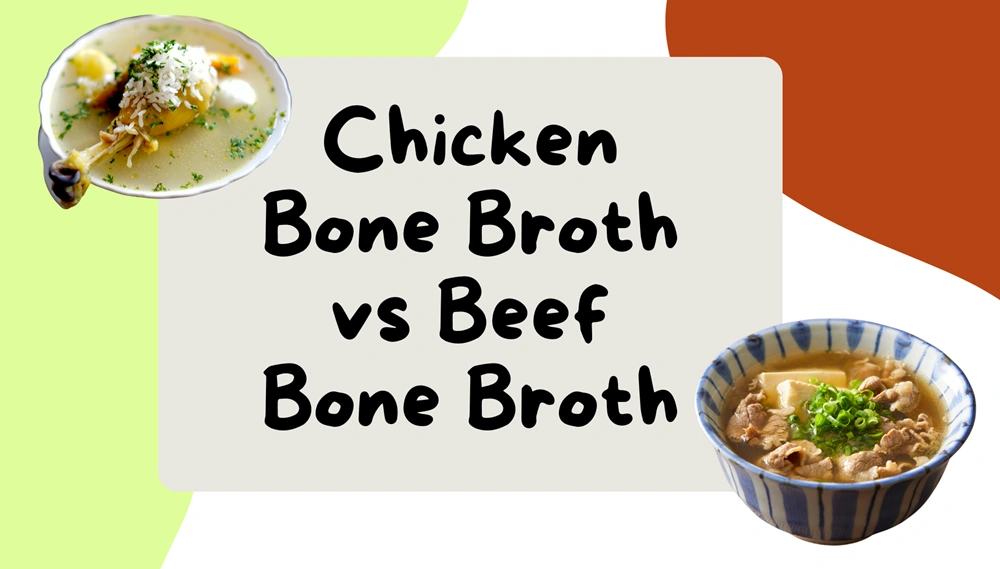Have you ever stood in the grocery store, staring at shelves packed with bone broth, wondering which one to grab? I’ve been there, torn between chicken and beef, trying to figure out which is the magic elixir for my health goals. Bone broth has become a wellness darling, praised for everything from soothing sore throats to boosting skin glow. But when it comes to chicken bone broth vs beef bone broth, how do you choose? Let’s dive into the simmering world of bone broth, exploring what makes each unique, their health benefits, and whether you might want to sip both. Spoiler: there’s no one-size-fits-all answer, but I’ll help you find what’s best for you.
What is Bone Broth?

Bone broth is like a warm hug in a mug, crafted by simmering animal bones—think chicken, beef, pork, or even fish—with veggies, herbs, and a splash of vinegar for 12 to 24 hours or more. This slow process pulls out a treasure trove of nutrients: collagen, amino acids, gelatin, and minerals like calcium and magnesium. Unlike regular broth, which is made from meat and simmers for just a couple of hours, bone broth’s long cook time makes it a nutrient powerhouse. It’s not just stock either—stock cooks for 4–6 hours, while bone broth goes the extra mile to extract every bit of goodness.
Why the hype? Bone broth is a versatile dietary supplement ingredient, used in everything from soups to smoothies. It’s a staple in sports nutrition for its muscle-supporting amino acids and is often touted for its role in joint health supplements. Whether you’re sipping it to soothe a cold or using it as a base for a hearty stew, bone broth is a kitchen MVP.
The Basics: Chicken Bone Broth vs Beef Bone Broth
Let’s get to the meat (or bones) of the matter: how do chicken and beef bone broth stack up nutritionally? Both are packed with nutrients, but their profiles differ in ways that might sway your choice.
Nutritional Comparison
Here’s a breakdown of the key nutritional differences, based on available data:
| Aspect | Chicken Bone Broth | Beef Bone Broth |
|---|---|---|
| Protein (per 250ml) | ~12g | ~10g |
| Collagen Type | Type II (joints, skin) | Types I and III (skin, gut) |
| Amino Acids | Higher BCAAs (leucine, isoleucine, valine) | Higher glycine, proline |
| Electrolytes | More potassium, magnesium, phosphorus | Slightly less |
| Fatty Acids | Higher omega-6 (grain-fed chickens) | Better omega-3:omega-6 ratio (grass-fed beef) |
| Calories | ~30–60 per cup | ~30–60 per cup |
- Protein: Chicken bone broth edges out with slightly more protein, around 12 grams per 250ml compared to beef’s 10 grams. This makes it a great choice for those focused on muscle recovery, especially in sports nutrition.
- Collagen: Beef bone broth, often made from denser bones, tends to have more collagen, particularly types I and III, which are key for skin and gut health. Chicken bone broth is rich in type II collagen, a star in joint health supplements.
- Amino Acids: Chicken broth boasts higher levels of branched-chain amino acids (BCAAs) like leucine, which support muscle growth. Beef broth, however, has more glycine and proline, aiding gut repair and sleep.
- Electrolytes: Chicken bone broth contains more hydrating electrolytes like potassium and magnesium, making it a go-to for hydration.
- Fatty Acids: Beef bone broth from grass-fed cattle often has a better omega-3 to omega-6 ratio, which may reduce inflammation compared to chicken broth from grain-fed birds.
Calories in both are low, typically 30–60 per cup, depending on preparation. Homemade broths may have fewer additives, while store-bought versions can vary in sodium and protein content.
Similarities and differences in chicken vs beef bone broth health benefits?

Both broths share a core set of benefits, but their unique nutrient profiles give each some distinct advantages.
Shared Benefits
- Gut Health: The gelatin and amino acids in both broths help repair the gut lining, potentially easing issues like leaky gut syndrome. This makes them valuable dietary supplement ingredients for digestive health.
- Joint Health: Collagen supports cartilage and connective tissue, which can reduce joint pain and stiffness.
- Skin Health: Collagen boosts skin elasticity and hydration, potentially reducing wrinkles.
- Immune Support: Nutrients like amino acids and minerals bolster the immune system, helping fight off colds and infections.
Unique Benefits
Chicken Bone Broth:
- Joint Health: Rich in chicken collagen type II, it’s particularly effective for joint health. A study published in Nutrients found that type II collagen can reduce knee pain in osteoarthritis patients (https://www.ncbi.nlm.nih.gov/pubmed/22956862).
- Skin Health: The same collagen type may improve skin hydration and reduce wrinkles, making it a natural beauty booster.
- Muscle Recovery: Higher BCAA content supports muscle growth and repair, ideal for athletes or those into sports nutrition.
Beef Bone Broth:
- Gut Health: Higher glycine levels promote stomach acid production and gut lining repair, making it a top pick for digestive wellness.
- Sleep and Mood: Glycine may shorten sleep onset and improve sleep quality, while also boosting serotonin for better mood.
- Energy Levels: The denser bones provide more minerals, which may enhance energy and overall nourishment.
These benefits depend on factors like bone quality and cooking time. Grass-fed or pasture-raised bones often yield a more nutrient-dense broth.
Taste and Culinary Uses of Chicken and Beef Bone Broth
Taste can be a dealbreaker when choosing between chicken and beef bone broth. Here’s how they compare:
- Chicken Bone Broth: Its light, delicate flavor makes it a kitchen chameleon. Use it in soups, sauces, risottos, or even smoothies for a nutrient boost without overpowering other ingredients. It’s also great for sipping with a pinch of salt and pepper.
- Beef Bone Broth: Bold and hearty, it’s perfect for robust dishes like beef stew, chili, or French onion soup. Its richer taste might be less versatile for lighter recipes but shines in comfort foods.
I’ve found chicken bone broth to be my go-to for quick weeknight soups, while beef bone broth elevates my weekend slow-cooker recipes. Your choice might depend on whether you prefer a subtle or strong flavor profile.
Is It Better to Use Them Together?
Why choose when you can have both? Combining chicken and beef bone broth can offer a balanced mix of nutrients. For example, you get the joint-supporting type II collagen from chicken and the gut-healing glycine from beef. This approach is like creating a custom formula for your health, blending the best of both worlds.
In practice, you might use chicken bone broth for lighter dishes and beef for heartier ones, or mix them in recipes for a nuanced flavor. Some companies even offer blended bone broth products, often marketed as containing bovine bone collagen peptide for added health benefits.
Ultimately, the decision comes down to your goals. If you’re focused on joint health, lean toward chicken. For gut health or better sleep, beef might be your pick. Or, if you’re like me and love variety, keep both in your pantry for different recipes and health needs.
Making Your Own Bone Broth
Want to try your hand at making bone broth? It’s easier than you think, though it takes time. Here’s a quick guide:
Chicken Bone Broth Recipe
- Ingredients: 2–3 lbs chicken bones (carcass, necks, feet), 1 onion, 2 carrots, 2 celery stalks, 2 tbsp apple cider vinegar, herbs (bay leaves, thyme), water.
- Steps: Place bones in a pot or slow cooker, add veggies, vinegar, and herbs. Cover with water. Bring to a boil, then simmer for 12–24 hours. Strain and store.
Beef Bone Broth Recipe
- Ingredients: 2–3 lbs beef bones (marrow, knuckles), 1 onion, 2 carrots, 2 celery stalks, 2 tbsp apple cider vinegar, herbs, water.
- Steps: Optionally roast bones at 400°F for 30 minutes. Place in a pot, add veggies, vinegar, and herbs. Cover with water. Simmer for 24–48 hours. Strain and store.
Using high-quality, grass-fed, or pasture-raised bones ensures a nutrient-rich broth, free from additives.
FAQs
Is beef or chicken bone broth healthier?
Both are nutritious, with similar benefits like supporting joint, gut, and skin health. Beef bone broth may have more minerals (magnesium, calcium), while chicken is often lighter and easier to digest. Healthiness depends on individual needs.
Which meat is best for bone broth?
No single “best” meat. Beef bones (e.g., marrow, knuckles) provide robust flavor and nutrients; chicken bones (e.g., feet, wings) are high in collagen and lighter. Pork or fish bones are also options, depending on taste and dietary needs.
What is the healthiest bone broth to consume?
The healthiest is homemade from high-quality, grass-fed, or pasture-raised bones, simmered 12–24 hours, with minimal additives. Organic store-bought versions are good if low in sodium and free of artificial ingredients.
Which bone broth has the most collagen?
Chicken bone broth, especially from feet, wings, or cartilage-rich parts, typically has more collagen than beef. Longer simmering (24+ hours) increases collagen content in both.
Is bone broth bad for cholesterol?
Bone broth has minimal impact on cholesterol for most people. It contains little fat if skimmed properly. Those with specific cholesterol concerns should consult a doctor, as individual responses vary.
Is chicken bone broth good for gut health?
Yes, chicken bone broth is rich in gelatin and amino acids (like glutamine) that may support gut lining repair, reduce inflammation, and aid digestion, especially for leaky gut or IBS.
Conclusion
In the showdown of chicken bone broth vs. beef bone broth, there’s no clear winner—both are nutritional powerhouses with unique strengths. Chicken bone broth is your ally for joint health, skin glow, and muscle recovery, while beef bone broth shines for gut health, sleep, and energy. Whether you choose one, both, or a mix depends on your taste, health goals, and cooking style. So, grab a mug, experiment with both, and discover which bone broth makes your body and taste buds sing.

